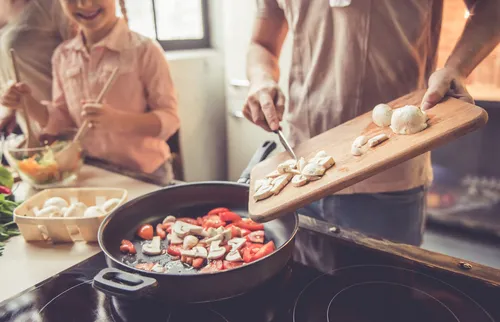 Written by Mike Price, OT
Written by Mike Price, OT
For people with low vision who are aging in place, the ability to be independent is at the forefront of their daily concerns.
Often, one of the major areas that this comes to fruition is in the kitchen.
Everyone eats and needs to prepare food and drinks multiple times a day, but the kitchen can be an obstacle course of challenges for a person with low vision.
Cutting food items, cooking, and preparing meals can be difficult and even dangerous if your kitchen isn’t properly accessible for low vision needs.
Thankfully, there are a variety of tricks and accessories available to help make cooking safe and easy for people with vision limitations.

All too often our kitchen cabinets are drawers are cluttered and difficult to navigate. Countertops are taken over, and we don’t have an inch of free space to use in meal preparation.
All of these problems become even more significant for people with a visual impairment.
The range of labeling systems available today includes a variety of options such as color-coding, braille, and even talking options.
Depending on what you find most functional, the type of household you’re a part of, and who else is using the kitchen, you may find different systems to be more effective.
No matter which system you use, try these ideas to help it be more functional:
For people with visual impairments, talking appliances and equipment can be a great boon. These tools are easy to operate without having to worry about the ability to see them.
They clearly read out timing, operational settings, and other options so that you can navigate things like temperature, color, volume measurement, and even different food labels.
Often, these talking tools are versatile, easy to use, and available with a range of different languages to accommodate a variety of user needs.
For better visibility of food preparation or meal plating, you can try divided plates or trays to make it easier to see the different foods.
Brightly colored dishes can also make it easier to see not only the dishes themselves but also the food on them, helping you eat more confidently.
Scooper plates and bowls can also be a great solution, helping you more confidently scoop food onto utensils without pushing it off the plate.
Nobody cooks or bakes without making a mess! But even so, individuals with visual impairment may become frustrated when they make messes or spill ingredients in the kitchen.
By using a shallow baking sheet or cafeteria tray as a food preparation area, you can easily contain spills thanks to the raised edge!
Simply containing the mess makes accidents a non-event, and helps a person with visual impairment remain motivated to make his or her own meals.
One other way to anticipate spills in the kitchen is to place larger dinner plates underneath dinnerware and bowls. The larger dinner plate will catch spills from the main plate, and will prevent potential frustration and embarrassment at mealtime!
Living with low vision doesn’t have to mean a loss of independence. Taking these simple steps should help put the joy back in cooking and preparing meals for yourself and your loved ones.
If you enjoyed this article and want to learn more about different topics relevant to caregiving and disabled living, check out some more of our great tips and tricks on Caregiver University.

Co-Founder of Rehabmart and an Occupational Therapist since 1993. Mike has spent his professional career working in multiple areas of Occupational Therapy, including pediatrics, geriatrics, hand therapy, ergonomics and inpatient / outpatient rehabilitation. Mike enjoys writing articles that help people solve complex therapeutic problems and make better product choices.